
A gas mask is an item of personal protective equipment used to protect the wearer from inhaling airborne pollutants and toxic gases. The mask forms a sealed cover over the nose and mouth, but may also cover the eyes and other vulnerable soft tissues of the face. Most gas masks are also respirators, though the word gas mask is often used to refer to military equipment, the scope used in this article. The gas mask only protects the user from digesting, inhaling, and contact through the eyes. Most combined gas mask filters will last around 8 hours in a biological or chemical situation. Filters against specific chemical agents can last up to 20 hours.

Personal protective equipment (PPE) is protective clothing, helmets, goggles, or other garments or equipment designed to protect the wearer's body from injury or infection. The hazards addressed by protective equipment include physical, electrical, heat, chemicals, biohazards, and airborne particulate matter. Protective equipment may be worn for job-related occupational safety and health purposes, as well as for sports and other recreational activities. Protective clothing is applied to traditional categories of clothing, and protective gear applies to items such as pads, guards, shields, or masks, and others. PPE suits can be similar in appearance to a cleanroom suit.

A firefighter is a first responder trained in firefighting, primarily to control and extinguish fires that threaten life and property, as well as to rescue persons from confinement or dangerous situations. Male firefighters are sometimes referred to as firemen.
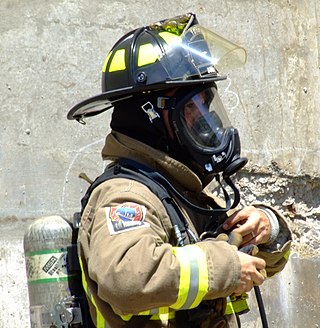
A self-contained breathing apparatus (SCBA) is a device worn to provide an autonomous supply of breathable gas in an atmosphere that is immediately dangerous to life or health. They are typically used in firefighting and industry. The term self-contained means that the SCBA is not dependent on a remote supply of breathing gas. If designed for use under water, it is also known as a scuba set. When not used underwater, they are sometimes called industrial breathing sets. Some types are also referred to as a compressed air breathing apparatus (CABA) or simply breathing apparatus (BA). Unofficial names include air pack, air tank, oxygen cylinder or simply pack, which are mostly used in firefighting.

Chemical, biological, radiological and nuclear defense or NBC protection is protective measures taken in situations in which chemical, biological, radiological or nuclear hazards may be present. CBRN defense consists of CBRN passive protection, contamination avoidance, and weapons of mass destruction mitigation.

Firefighting is a profession aimed at controlling and extinguishing fire. A person who engages in firefighting is known as a firefighter or fireman. Firefighters typically undergo a high degree of technical training. This involves structural firefighting and wildland firefighting. Specialized training includes aircraft firefighting, shipboard firefighting, aerial firefighting, maritime firefighting, and proximity firefighting.

The Expert Field Medical Badge (EFMB) is a United States Army special skills badge first created on June 18, 1965. This badge is the non-combat equivalent of the Combat Medical Badge (CMB) and is awarded to U.S. military personnel and North Atlantic Treaty Organization (NATO) military personnel who successfully complete a set of qualification tests, including both written and performance portions. The EFMB is known for its adherence to its testing standards and, as such, requires strict attention to detail from candidates in order to receive a "GO" on its combat testing lanes. The pass rate for FY 2017 was 7%, making the EFMB one of the most difficult and prestigious Army special skill badges to earn.

Nomex is a flame-resistant meta-aramid material developed in the early 1960s by DuPont and first marketed in 1967.

A respirator is a device designed to protect the wearer from inhaling hazardous atmospheres including fumes, vapours, gases and particulate matter such as dusts and airborne pathogens such as viruses. There are two main categories of respirators: the air-purifying respirator, in which respirable air is obtained by filtering a contaminated atmosphere, and the air-supplied respirator, in which an alternate supply of breathable air is delivered. Within each category, different techniques are employed to reduce or eliminate noxious airborne contaminants.

A hazmat suit is a piece of personal protective equipment that consists of an impermeable whole-body garment worn as protection against hazardous materials.

MOPP is protective gear used by U.S. military personnel in a toxic environment, e.g., during a chemical, biological, radiological, or nuclear (CBRN) strike:

ILC Dover, LP is a special engineering development and manufacturing company, globally headquartered in Newark, Delaware. ILC Dover specializes in the use of high-performance flexible materials, serving the aerospace, personal protection, and pharmaceutical industries.

Aircraft rescue and firefighting (ARFF) is a type of firefighting that involves the emergency response, mitigation, evacuation, and rescue of passengers and crew of aircraft involved in aviation accidents and incidents.
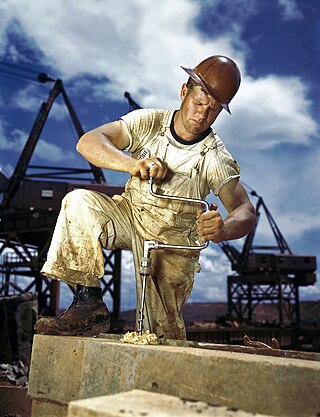
Mine Safety Appliances, or MSA Safety Incorporated, is an American manufacturer and supplier of safety equipment designed for use in a variety of hazardous conditions in industries such as construction, the military, fire service, and chemical, oil, and gas production.
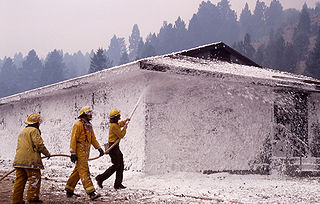
Firefighting foam is a foam used for fire suppression. Its role is to cool the fire and to coat the fuel, preventing its contact with oxygen, thus achieving suppression of the combustion. Firefighting foam was invented by the Russian engineer and chemist Aleksandr Loran in 1902.
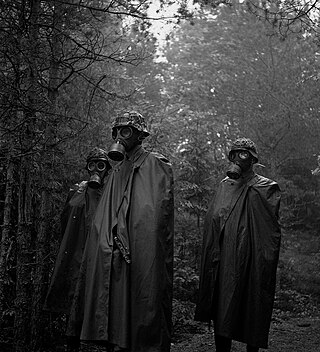
An NBC suit, also called a chem suit, or chemical suit is a type of military personal protective equipment. NBC suits are designed to provide protection against direct contact with and contamination by radioactive, biological, or chemical substances, and provide protection from contamination with radioactive materials and all types of radiation. They are generally designed to be worn for extended periods to allow the wearer to fight while under threat of or under actual nuclear, biological, or chemical attack. The civilian equivalent is the hazmat suit. The term NBC has been replaced by CBRN, with the addition of the new threat of radiological weapons.

Bunker gear is the personal protective equipment (PPE) used by firefighters. The term is derived from the fact that the trousers and boots are traditionally kept by the firefighters bunk at the fire station to be readily available for use.
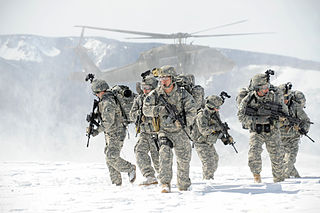
The Extended Cold Weather Clothing System is a protective clothing system developed in the 1980s by the United States Army Natick Soldier Research, Development and Engineering Center, Natick, Massachusetts. The first generation ECWCS consisted of parka and trousers plus 20 other individual clothing, handwear, headwear and footwear items which are used in various combinations to meet the cold weather environmental requirements of the US military. The Extended Climate Warfighter Clothing System, or Gen III ECWCS, is designed to maintain adequate environmental protection in temperatures ranging between -60° and +40° Fahrenheit
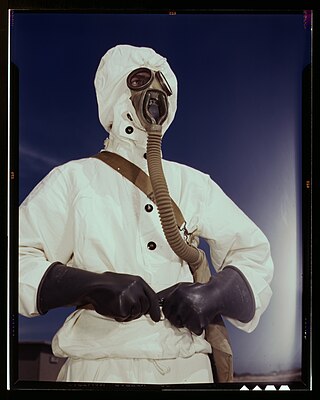
Chemical protective clothing (CPC) is clothing worn to shield those who work with chemicals from the effects of chemical hazards that can cause injuries on the job. It provides a last line of defense for chemical safety; it does not replace more proactive measures like engineering controls.



















